GUITAR BRIDGE TYPES
There were 7 types of guitar bridges offered by
Steinberger: 5 were tremolos and 2 were fixed bridges:
Tremolos
TransTrem
Bearing pivot tremolo designed for transposing of
strings and chords in tune. If you're here, you've probably already heard or know about
these. It's the only Steinberger bridge (actually one of the only production
guitar bridges ever) that offers a transposing
feature.
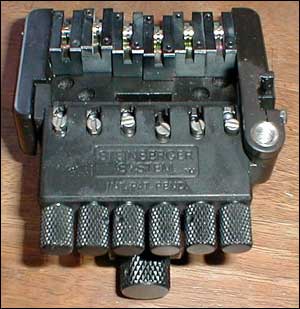
Newer Zen-On made Type2 TransTrem
Click here for
official directions on setting up a TransTrem.
There were two major versions of the TransTrem
(commonly abbreviated 'TT'): the introductory design (Type1) and a re-designed one (Type2). Technically there is a third type which
consists of a Type1 unit which has been factory retrofitted with some of the
parts and features of a Type2. These are now said to have had the 'trem
retro mod' or are simply called a 'Type1 retro.'
Click here
for more pictures, background and helpful tips on setup
& use.
S-Trem
Bearing pivot trem similar to TransTrem, but
without a transposing feature. Think of it as a non-transposing TransTrem.
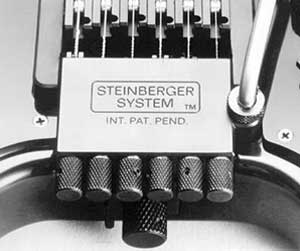
B&W pic of an S-Trem (from the original Steinberger
website)
NOTE: S-Trems and TransTrems utilize the same
basic body route and are considered interchangeable. They are the only two
trems that can be swapped without major modification.
R-Trem
Traditional knife edge trem. A completely different
design from Trans and S-Trems, it also allows for more fixed bridge like
operation when locked. It was made specifically as a more economical (read
cheaper) option and was featured on the lower end GR line of guitars. Now
offered on the wood neck Spirit line from MusicYo.
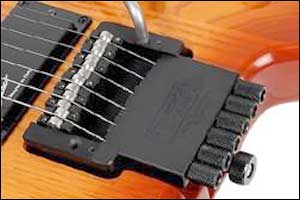
Newer R-Trem pictured on a new MusicYo
Spirit GU guitar
Z-Trem
Modified knife edge R-Trem design which included
a knife edge nut. It was made specifically for the GS headed guitars. This
design eliminated the need for a clamping nut ala Floyd Rose.
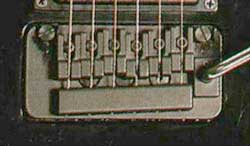
Pic (albeit fuzzy) of a GS Z-Trem
Jam Trem
Ned's most 'recent' trem design was a more basic
knife edge design with a better system for locking the bridge. Very few were
made and they were installed only on the GS headstock guitars. Rumor is that most
of these went overseas to Australia and the Far East. Ned claims this is the
best design for those who complain that trems kill sustain, as it comes closest
to providing 'fixed bridge' results when locked.
Jam Trem pic needed
Whereas the Trans and S-Trems have a bearing and
shaft unit that provides the pivot point, a knife edge trem consists of a bar or
points that fit into slot on each side. Most guitar trems are knife edge in
nature and this is the oldest and most proven design. The pressure of the strings keeps the
"knife" in the slot. The key benefit is that there are no moving parts.
Ned says this is actually a better overall design for tremolos. However, it
can't be used for a transposing situation - the bridge is too 'loose' to operate
properly Knife edge
trems are not foolproof, as the pivots can wear/loosen/misalign causing usage
problems.
It's also interesting to note that ball bearings
(as used in the S and TT) are designed for true
rotational (circular) movement and not the very small linear (back- and-forth)
motion on the S-Trem and TT. From a pure engineering standpoint they are
the wrong component to use in a tremolo. With normal playing Trans and S-Trem
bearings should to be replaced every couple of years, as the constant movement
of the bearings in relatively small path causes excessive wear. (Click
here for more info).
But these facts don't
diminish from the sheer genius of Ned's radical approach and design.
Fixed bridges
6
string hardtail
Only offered on early GL equipped
guitars. Most of the prototype GL's we've seen have them, and they were
offered mostly while Ned was busy developing his revolutionary TransTrem.
They were never really popular, especially after the TT came out. They
were discontinued
after a few years.
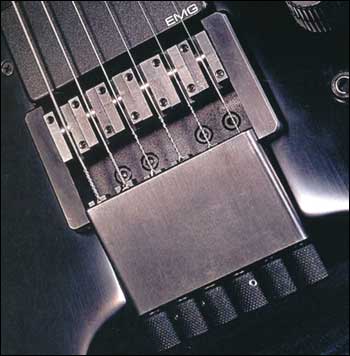
Estimates are of at most a
couple hundred hardtails almost exclusively on the earliest GL's. All were steel and custom milled in
the Steinberger factory. This solid construction technique contributes
to the exceptional sound these guitars produce. Notes are clear and they
have sustain that "lasts for days."
Early ones (including the
prototypes) are similar to the v1 L2 bass bridges with three bolts on the top
plate of the bridge. The later ones have a "clean" face like
the one pictured above
MusicYo has commissioned Ned to
design a new hardtail for the reissued graphite neck models. Arrival is
anticipated in late 2003 and may include a piezo option as well.
12
string TracTuner
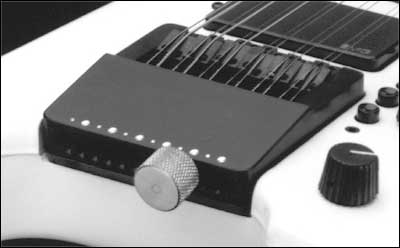
Official b&w press photo of the TracTuner
12 string bridge
Yet another revolutionary
Steinberger design. With traditional 12 strings the sheer number of
tuners is daunting. With a tuning bridge, Ned realized that a radical
approach was needed to avoid a jungle of knobs and keep it simple.
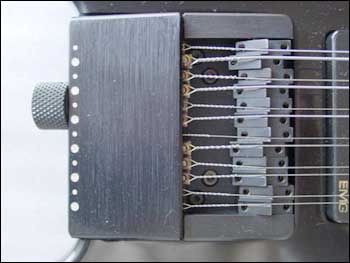
Overhead shot of a TracTuner on a black GL12
The TracTuner consists of a
single knob which runs along a track inside the bridge. There are 12
"Click points" which allow the tuner to be precisely positioned.
When "clicked in" the tuning knob engages a screw that provides
tuning for each individual jaw/string. The bridge also incorporates 12
individual saddles which provide the proper string spacing and precise intonation.
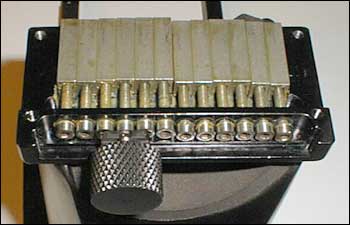
Inside view of the tuner and knob
assembly.
This is the actually
top
plate shown upside down.
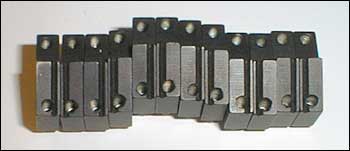
Close-up view of the TracTuner saddles.
Each "block" is actually a
pair of individually adjustable saddles.
The TracTuner option was
offered on the GL's and GM's throughout the bulk of production.
At most maybe a hundred or so were sold. Because they are rare
they command top dollar in the used market.








